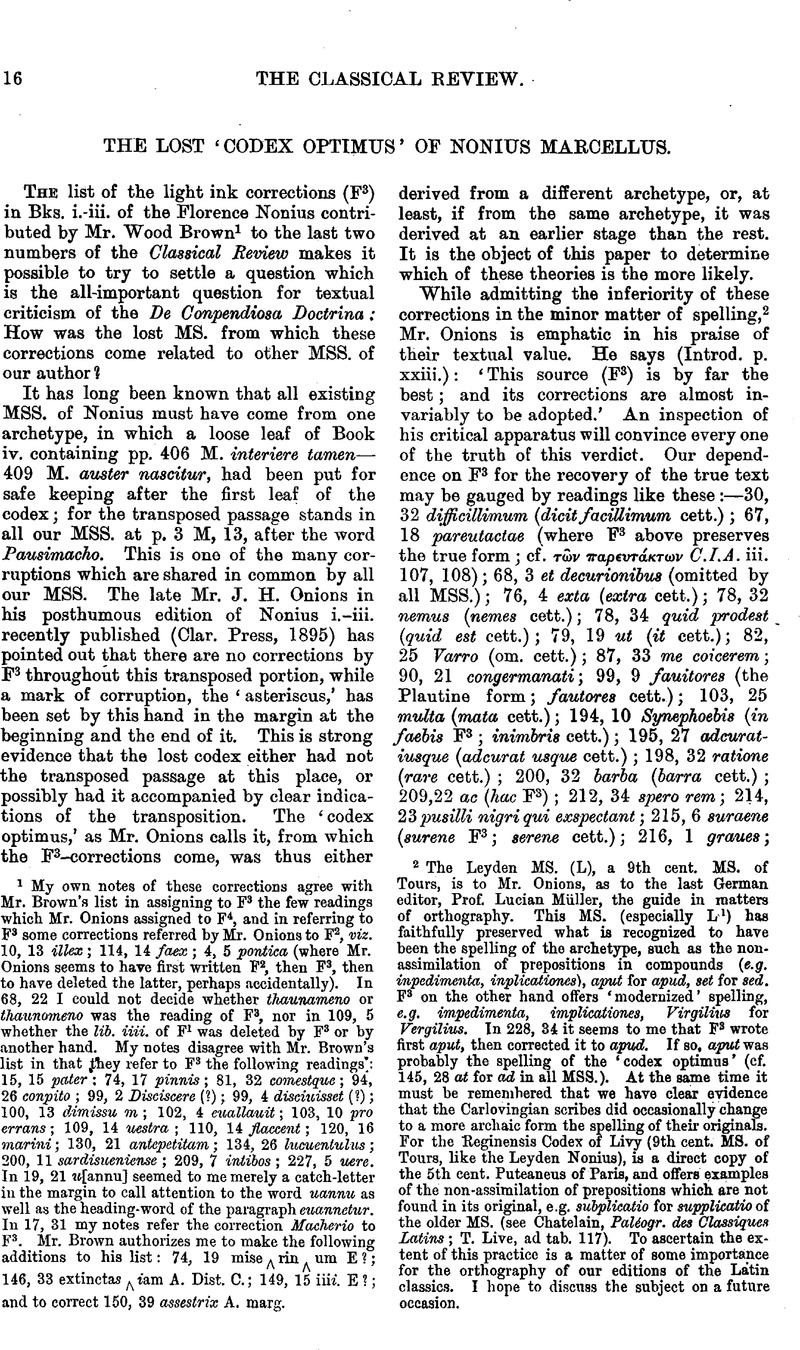No CrossRef data available.
Article contents
The Lost ‘Codex Optimus’ of Nonius Marcellus
Published online by Cambridge University Press: 27 October 2009
Abstract

- Type
- Review Article
- Information
- Copyright
- Copyright © The Classical Association 1896
References
page 16 note 1 My own notes of these corrections agree with Mr. Brown's list in assigning to F3 the few readings which Mr. Onions assigned to F4, and in referring to F3 some corrections referred by Mr. Onions to F2, viz. 10, 13 illex; 114, 14 faex; 4, 5 pontiea (where Mr. Onionsseems to have first written F2, then F3, then tohave deleted the latter, perhaps accidentally). In 68, 22 I could not decide whether thaunameno or thaunomeno was the reading of F3, nor in 109, 5 whether the lib. iiii. of F1 was deleted by F3 or by another hand. My notes disagree with Mr. Brown's list in that they refer to F3 the following readings': 15, 15 pater; 74, 17 pinnis; 81, 32 comestque; 94, 26 conpito; 99, 2 Disciscere (?); 99, 4 disciuissct (?); 100, 13 dimissu m; 102, 4 euallauit; 103, 10 proerrans; 109, 14 uestra; 110, 14 flaccent; 120,16 marini; 130, 21 antepetitam; 134, 26 lucuenlulus; 200, 11 surdisueniense; 209, 7 inlibos; 227, 5 uere. In 19, 21 u[annu] seemed to me merely a catch-letter in the margin to call attention to the word uannu as well as the heading-word of the paragraph euannetur. In 17, 31 my notes refer the correction Macherio to F3. Mr. Brown authorizes me to make the following additions to his list: 74, 19 mise rin um E?; 146, 33 extinctas Aiam A. Dist. C.; 149, 15 iii. E ?; and to correct 150, 39 assestrix A. marg.
page 16 note 2 The Leyden MS. (L), a 9th cent. MS. of Tours, is to Mr. Onions, as to the last German editor, Prof. Lucian Müller, the guide in matters of orthography. This MS. (especially Ls1) hasfaithfully preserved what is recognized to have been the spelling of the archetype, such as the nonassimilation of prepositions in compounds(e.g. inpedimenta, inplicationes), aput for apud, set for sed.F3 on the other hand offers ‘modernized’spelling, e.g. impedimenta, implicationes, Virgilius for Vergilius. In 228, 34 it seems to me that F3 wrote first aput, then corrected it to apud. If so, aput was probably the spelling of the ‘codex optimus’ (cf. 145, 28 at for adin all MSS.). At the same time it must be remembered that we have clear evidence that the Carlovingian scribes did occasionally change to a more archaic form the spelling of their originals.For the Reginensis Codex of Livy (9th cent. MS. of Tours, like the Leyden Nonius), is a direct copy of the 5th cent. Puteaneus of Paris, and offers examples of the non-assimilation of prepositions which are not found in its original, e.g. subplicatio for supplicato of the older MS. (see Chatelain, Paliogr. des Classiques Latins; T. Live, ad tab. 117). To ascertain the extent of this practice is a matter of some importance for the orthography of our editions of the Latin classics. I hope to discuss the subject on a future occasion.
page 17 note 1 Mr. Brown suggests that the original reading may be graece τ ντλa with τ suprascript in the archetype.
page 17 note 2 This relationship I have tried to establish in the Classical Review for October of last year (pp. 356 sq.).


